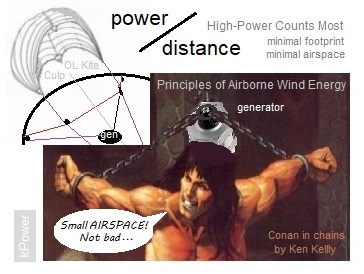

| Topic for open discussion: Least
Motion Principle in AWE
|
|
Send
AWE notes and topic replies to editor@upperwindpower.com
|
| ?next? |
| July 26, 2020, post by Dave Santos Least Motion Principle in AWE Dave Culp was asked in 2007 to list all the ways he knew to stabilize a kite. Everybody knows about tails, and experts know a few more stabilizer design tricks, but what stood out was his mention of "staking-out" a kite to stabilize it, which is a distinct topology. Show kite pros like PL Sr and Gomberg, and many Kite Golden Age pioneers had their versions of this method. The paleolithic playsail is essentially staked out by its flyers. DaveC's OL kite is a glorified playsail, scalable to about 2000m2, and ratable to about 10MW, and stake-able like King Kong. The small inventive leap was to see that a staked out power kite can work against its fetters like King Kong or Conan below. Let the kite out a bit and/or bring the anchors closer, and powerful spontaneous "kite grunt" oscillations develop, but the kite is closely kept in-bounds by its rigged topological stability factor. The oscillations are optimally tapped by crosswind PTO lines. Launching and killing is easily done by the nose and third-line. This is a unit-cell basis for vastly scaled-up kite lattices. Surely DaveC will be pleased with such a basic AWE solution. |